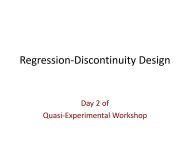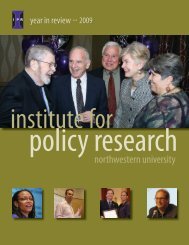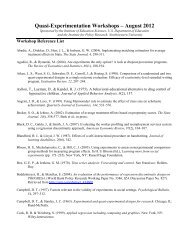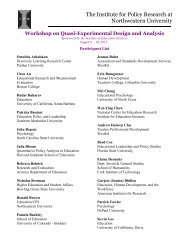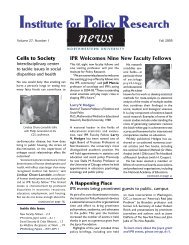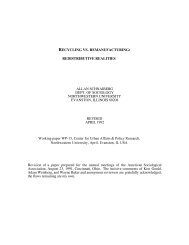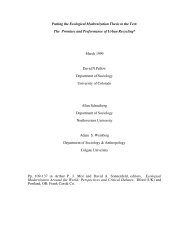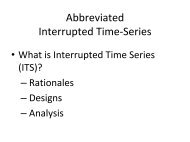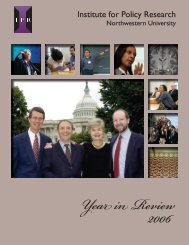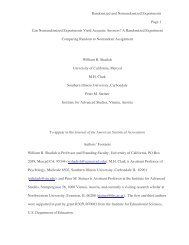IPR - Institute for Policy Research - Northwestern University
IPR - Institute for Policy Research - Northwestern University
IPR - Institute for Policy Research - Northwestern University
You also want an ePaper? Increase the reach of your titles
YUMPU automatically turns print PDFs into web optimized ePapers that Google loves.
published articles and chapters<br />
variation and the challenge of innovation. Educational<br />
Evaluation and <strong>Policy</strong> Analysis 30(4): 319–43.<br />
Reininger, M., with K. Hammerness. 2008. Who goes into<br />
early-entry programs? In Alternative Routes to Teaching:<br />
Mapping the New Landscape of Teacher Education, ed.<br />
P. Grossman and S. Loeb. Cambridge, Mass.: Harvard<br />
Education Press.<br />
Jennifer Richeson<br />
Richeson, J., and S. Trawalter. 2008. The threat of<br />
appearing prejudiced and race-based attentional biases.<br />
Psychological Science 19(2): 98–102.<br />
Richeson, J., S. Trawalter, and A. Baird. 2008. Eye-gaze<br />
direction modulates race-related amygdala activity. Group<br />
Processes & Intergroup Relations 11(2): 233–46.<br />
Chiao, J., R. Adams Jr., P. Tse, W. Lowenthal, J. Richeson,<br />
and N. Ambady. 2008. Knowing who’s the boss: fMRI and<br />
ERP investigations of social dominance perception. Group<br />
Processes & Intergroup Relations 11(2): 201–14.<br />
Krendl, A., J. Richeson, W. Kelley, and T. Heatherton.<br />
2008. The negative consequences of threat: A functional<br />
magnetic resonance imaging investigation of the neural<br />
mechanisms underlying women’s underper<strong>for</strong>mance in<br />
math. Psychological Science 19(2): 168–75.<br />
Trawalter, S., and J. Richeson. 2008. Let’s talk about<br />
race, Baby! When whites’ and blacks’ interracial contact<br />
experiences diverge. Journal of Experimental Social<br />
Psychology 44(4): 1214–17.<br />
Trawalter, S., A. Todd, A. Baird, and J. Richeson. 2008.<br />
Attending to threat: Race-based patterns of selective<br />
attention. Journal of Experimental Social Psychology 44(5):<br />
1322–27.<br />
Andrew Roberts<br />
Roberts, A. 2008. Hyperaccountability: Economic voting in<br />
Central and Eastern Europe. Electoral Studies 27(3): 533–46.<br />
Roberts, A., with J. Druckman. 2008. Measuring portfolio<br />
salience in Eastern European parliamentary democracies.<br />
European Journal of Political <strong>Research</strong> 41(1): 101–34.<br />
Dorothy Roberts<br />
Roberts, D. 2008. The racial geography of state child<br />
protection. In New Landscapes of Inequality: Neoliberalism<br />
and the Erosion of Democracy in America, ed. J. Collins, M.<br />
di Leonardo, and B. Williams, 153–68. Sante Fe, N.M.:<br />
SAR Press.<br />
Roberts, D. 2008. Race and the new reproduction;<br />
Making reproduction a crime. In The Reproductive Rights<br />
Reader: Law, Medicine, and the Construction of Motherhood,<br />
ed. N. Ehrenreich, 308–19 and 368–86. New York: New<br />
York <strong>University</strong> Press.<br />
Roberts, D. 2008. Is race-based medicine good <strong>for</strong> us?<br />
African American approaches to race, biomedicine, and<br />
equality. Journal of Law, Medicine & Ethics 36(3): 537–45.<br />
Roberts, D. 2008. The racial geography of child welfare:<br />
Toward a new research paradigm. Child Welfare 87(2):<br />
125–50.<br />
Roberts, D. 2008. Torture and the biopolitics of race.<br />
<strong>University</strong> of Miami Law Review 62(2): 229–48.<br />
James Rosenbaum<br />
Rosenbaum, J., with K. White. 2008. Inside the black<br />
box of accountability: How high-stakes accountability<br />
alters school culture and the classification and treatment<br />
of students and teachers. In No Child Left Behind and<br />
the Reduction of the Achievement Gap, ed. A. Sadovnik, J.<br />
“<br />
Establishing and en<strong>for</strong>cing standards and norms regarding the expression of bias are of paramount<br />
importance to the creation of a more harmonious, yet diverse, society. The present results suggest, however, that<br />
such standards may unwittingly encourage anxious reactions and threat responses toward members of relevant<br />
out-groups—reactions that are revealed even in basic components of visual attention.<br />
”<br />
Richeson, J., and S. Trawalter. 2008. The threat of appearing prejudiced and race-based attentional biases.<br />
Psychological Science 19(2): 98–102 (p. 102).<br />
60



